Retro Replay Review
Gameplay
Bones: The Game of the Haunted Mansion delivers a hybrid experience that blends boardgame-style exploration with classic roguelike dungeon crawling. You move from room to room in a haunted mansion, each chamber revealed in text-based “windows” reminiscent of late DOS titles. As you explore, you’ll face skeletons of every variety—paper skeletons, flying skeletons, paranoid skeletons, closet skeletons, thief skeletons—and must decide whether to fight or parley with these undead foes. Choosing dialogue over combat can preserve precious hit points and occasionally yield hints about nearby treasures or traps.
(HEY YOU!! We hope you enjoy! We try not to run ads. So basically, this is a very expensive hobby running this site. Please consider joining us for updates, forums, and more. Network w/ us to make some cash or friends while retro gaming, and you can win some free retro games for posting. Okay, carry on 👍)
Item discovery is a core pillar of Bones’ gameplay. Rooms are described in vague detail, forcing you to examine your surroundings carefully. Instead of labeling loot outright, the game might tell you that you see “round disks” rather than gold coins. In more extreme cases, items appear only as “something,” and you must experiment with commands to identify artifacts, RAM chips, ammo clips or magical scrolls. This guessing element adds a puzzle-like tension to each encounter and rewards careful note-taking.
A unique twist in Bones is its resource-bound auto-mapping feature: the Bonebuster Mansion Mapper. Unlike most roguelikes with free mapping, here you need both Video RAM and Main RAM chips to power the mapper. Each kilobyte you install stores or displays exactly one room, making RAM chips among the most coveted—and scarce—resources in the mansion. Balancing the need for mapping against other uses of RAM, like running complex spells or operating the laser weapons, deepens the strategic layer of the game.
Combat and survival hinge on an eclectic arsenal that ranges from bare-handed bashes to futuristic weaponry. While bones dropped by slain skeletons can serve as makeshift clubs, swords and maces offer more consistent damage. For those lucky enough to track them down, Uzis and laser guns become game-changing tools—though you must locate and identify ammo clips or energy cells before they can truly turn the tide. Strategic resource management, combined with the gamble of guessing unidentified gear, keeps each playthrough fresh and fraught with risk.
Graphics
Bones takes a decidedly retro approach to visuals. Aside from a modest BGI title screen, all action unfolds in monochrome text windows. This aesthetic might feel barebones by modern standards, but it perfectly evokes the early 1980s DEC mainframe era where the Wizard’s Castle family first emerged. The lack of pixel art or sprites shifts the focus entirely onto your imagination.
The windowed interface, featuring nested panes for room descriptions, status readouts, and inventory lists, recalls late-DOS interactive fiction or administrative utilities of the period. It may seem austere, but the clean separation of information channels makes it easy to track your character’s health, equipment, and mapping progress without clutter. For players who appreciate minimalism and clarity over flash, it’s a welcome design choice.
In lieu of dynamic visuals, Bones uses vivid textual descriptions to convey the dusty corridors, cobwebbed halls, and skeleton-strewn rooms of the haunted mansion. Occasional ASCII-style outlines—like a skull icon on the title screen—set the mood before you delve into the purely textual depths. This sparseness encourages immersion in the story and gameplay systems rather than in flashy graphics.
Story
The narrative of Bones: The Game of the Haunted Mansion is straightforward yet satisfying in its familiarity. As with its Wizard’s Castle siblings, you are tasked with descending into the depths of an otherworldly dungeon—in this case, a sprawling haunted mansion—to retrieve the all-powerful Globe of a long-dead Warlock. The plot provides enough context to motivate exploration, pitting you against undead guardians and ancient traps.
Despite its conservative framework, Bones weaves together elements of fantasy, horror, and sci-fi. You traverse dusty ballrooms and cramped laboratories, uncover RAM chips to power your auto-mapper, and arm yourself with everything from swords to laser rifles. The juxtaposition of archaic magic, skeletal sentries, and futuristic weaponry creates a unique tonal blend that surprises at every turn.
Encounters with skeletons aren’t purely combative. Occasionally, you can negotiate—or at least bluff—your way past certain undead variants to conserve health or glean cryptic hints about the mansion’s layout. These brief narrative flourishes add character to what could otherwise be a cold, procedural dungeon crawl.
Overall Experience
Bones: The Game of the Haunted Mansion offers a time-capsule experience steeped in early roguelike and interactive fiction traditions. Players who value deep resource management, randomized encounters, and text-driven storytelling will find it a rewarding challenge. The single monster type and text-only interface may deter those seeking vivid visuals or a wide bestiary, but for fans of minimalistic design and emergent gameplay, it’s a hidden gem.
The game’s steep learning curve—driven by cryptic item descriptions, scarce mapping resources, and punishing traps—can feel unforgiving at first. However, perseverance is handsomely rewarded as you learn to interpret room cues, manage RAM allocation, and optimize your equipment loadout. Each new memory chip discovered or Uzi clip identified brings a tangible sense of progress.
Though primarily of interest to nostalgia hunters and roguelike purists, Bones has a timeless quality. The haunted mansion’s atmospheric prose and the strategic depth of its auto-mapping mechanic ensure that even seasoned adventurers will find fresh challenges on each run. For anyone seeking an old-school, text-based dungeon crawl with a twist, Bones delivers a uniquely satisfying journey into a mansion haunted by dust, bones, and the echoes of mainframe lore.
 Retro Replay Retro Replay gaming reviews, news, emulation, geek stuff and more!
Retro Replay Retro Replay gaming reviews, news, emulation, geek stuff and more!
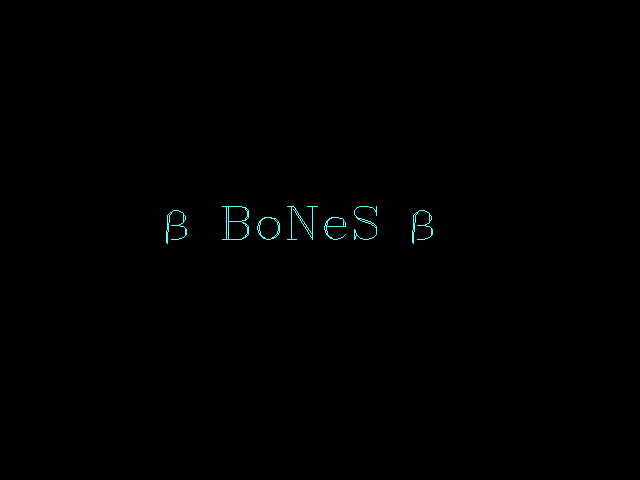
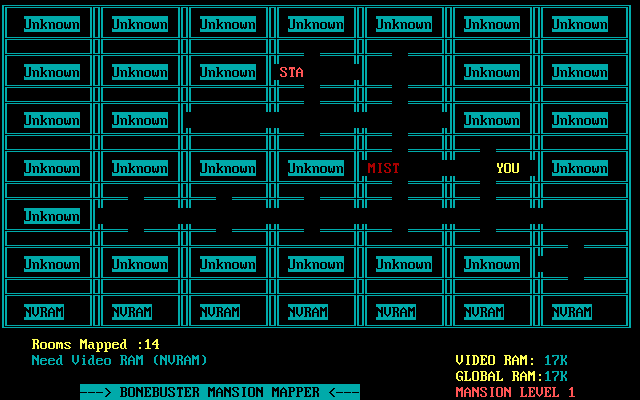
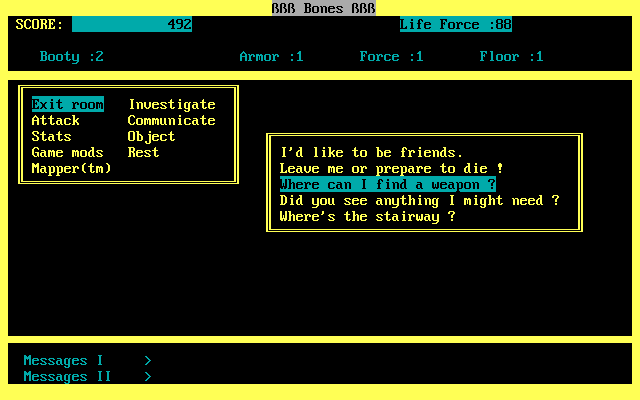
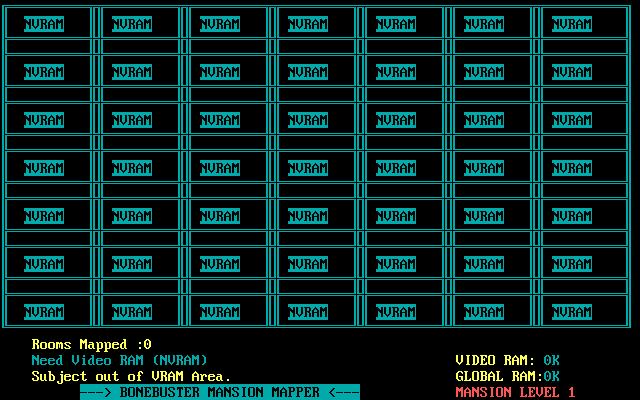
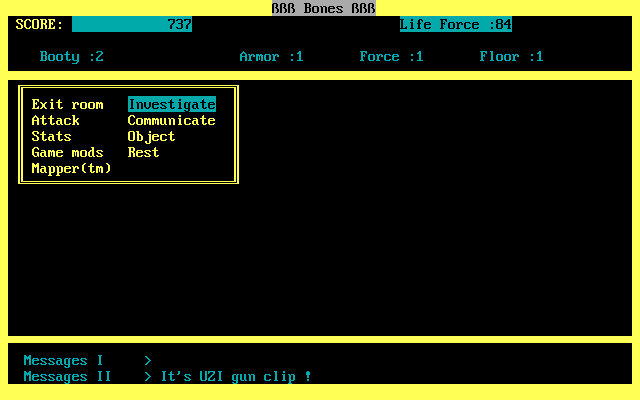
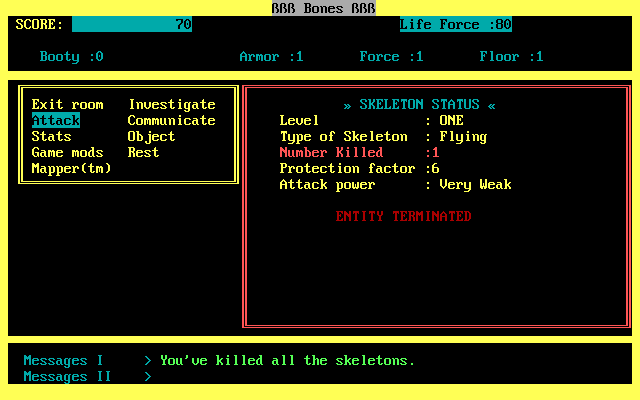



Reviews
There are no reviews yet.